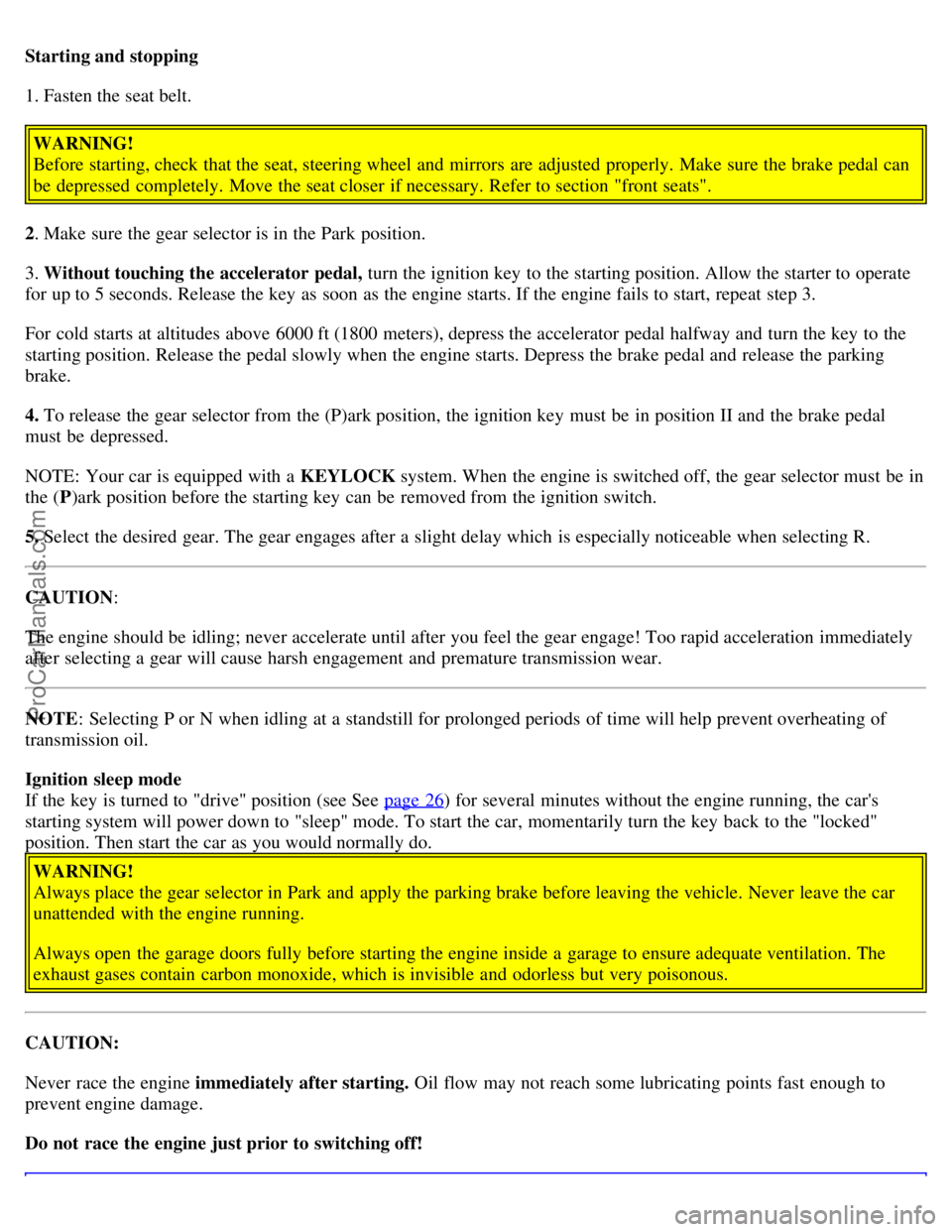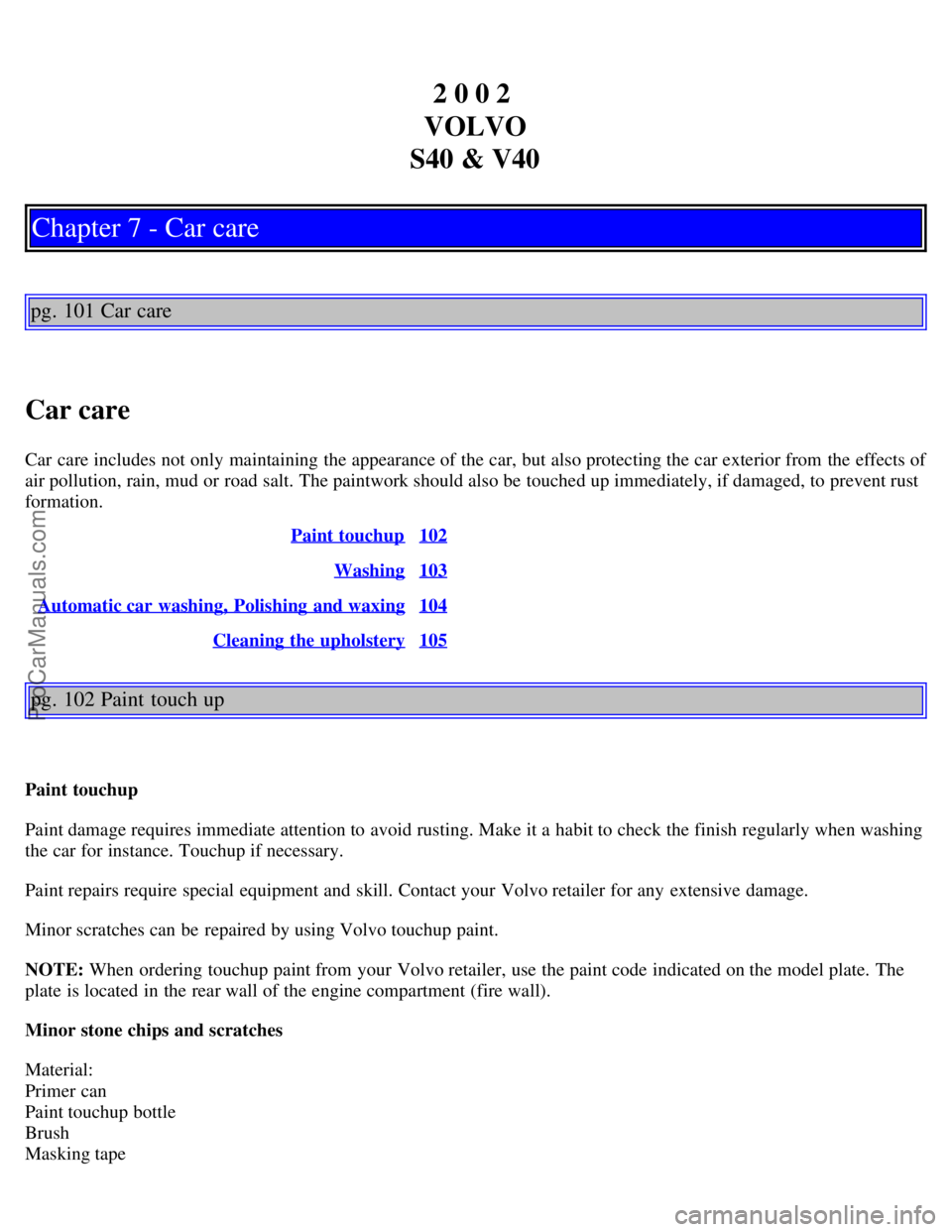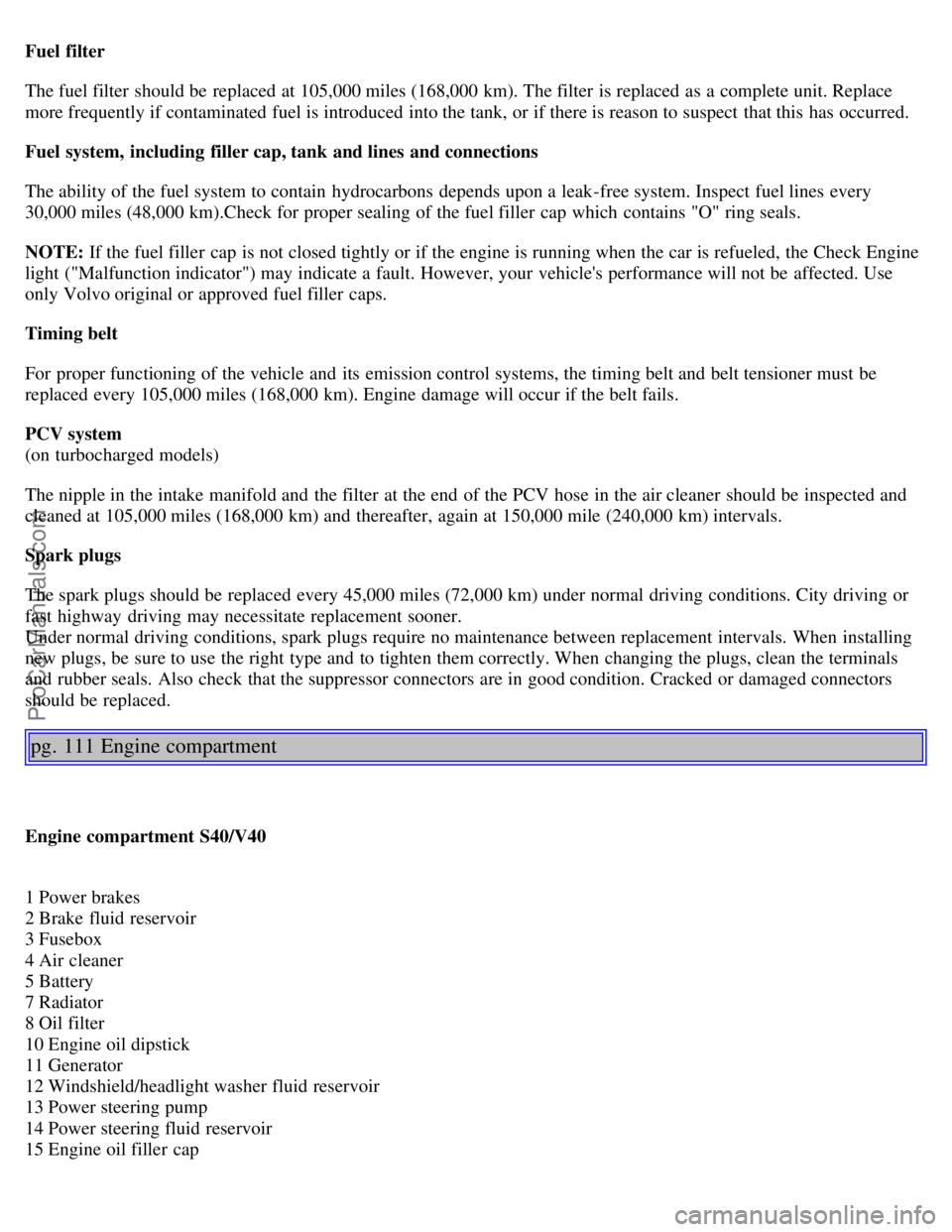check engine VOLVO V4 2002 User Guide
[x] Cancel search | Manufacturer: VOLVO, Model Year: 2002, Model line: V4, Model: VOLVO V4 2002Pages: 88, PDF Size: 2.34 MB
Page 34 of 88

Starting and stopping
1. Fasten the seat belt.WARNING!
Before starting, check that the seat, steering wheel and mirrors are adjusted properly. Make sure the brake pedal can
be depressed completely. Move the seat closer if necessary. Refer to section "front seats".
2. Make sure the gear selector is in the Park position.
3. Without touching the accelerator pedal, turn the ignition key to the starting position. Allow the starter to operate
for up to 5 seconds. Release the key as soon as the engine starts. If the engine fails to start, repeat step 3.
For cold starts at altitudes above 6000 ft (1800 meters), depress the accelerator pedal halfway and turn the key to the
starting position. Release the pedal slowly when the engine starts. Depress the brake pedal and release the parking
brake.
4. To release the gear selector from the (P)ark position, the ignition key must be in position II and the brake pedal
must be depressed.
NOTE: Your car is equipped with a KEYLOCK system. When the engine is switched off, the gear selector must be in
the ( P)ark position before the starting key can be removed from the ignition switch.
5. Select the desired gear. The gear engages after a slight delay which is especially noticeable when selecting R.
CAUTION :
The engine should be idling; never accelerate until after you feel the gear engage! Too rapid acceleration immediately
after selecting a gear will cause harsh engagement and premature transmission wear.
NOTE : Selecting P or N when idling at a standstill for prolonged periods of time will help prevent overheating of
transmission oil.
Ignition sleep mode
If the key is turned to "drive" position (see See page 26
) for several minutes without the engine running, the car's
starting system will power down to "sleep" mode. To start the car, momentarily turn the key back to the "locked"
position. Then start the car as you would normally do.
WARNING!
Always place the gear selector in Park and apply the parking brake before leaving the vehicle. Never leave the car
unattended with the engine running.
Always open the garage doors fully before starting the engine inside a garage to ensure adequate ventilation. The
exhaust gases contain carbon monoxide, which is invisible and odorless but very poisonous.
CAUTION:
Never race the engine immediately after starting. Oil flow may not reach some lubricating points fast enough to
prevent engine damage.
Do not race the engine just prior to switching off!
ProCarManuals.com
Page 37 of 88

Transmission Lamp
If the indicator lamp (see page 21 item 18
) begins to flash, this is an indication of a fault in the automatic transmission.
The Check Engine Lamp will also light up if a fault is detected. If the transmission does not shift properly, place the
gear selector in position L. Please contact your Volvo retailer if this occurs.
Contents | Top of Page
ProCarManuals.com
Page 53 of 88

2 0 0 2
VOLVO
S40 & V40
Chapter 7 - Car care
pg. 101 Car care
Car care
Car care includes not only maintaining the appearance of the car, but also protecting the car exterior from the effects of
air pollution, rain, mud or road salt. The paintwork should also be touched up immediately, if damaged, to prevent rust
formation. Paint touchup
102
Washing103
Automatic car washing, Polishing and waxing104
Cleaning the upholstery105
pg. 102 Paint touch up
Paint touchup
Paint damage requires immediate attention to avoid rusting. Make it a habit to check the finish regularly when washing
the car for instance. Touchup if necessary.
Paint repairs require special equipment and skill. Contact your Volvo retailer for any extensive damage.
Minor scratches can be repaired by using Volvo touchup paint.
NOTE: When ordering touchup paint from your Volvo retailer, use the paint code indicated on the model plate. The
plate is located in the rear wall of the engine compartment (fire wall).
Minor stone chips and scratches
Material:
Primer can
Paint touchup bottle
Brush
Masking tape
ProCarManuals.com
Page 59 of 88

(on inside of fuel filler door)
4 Model plate
Vehicle Identification Number (VIN). Codes for color and upholstery, etc. The plate is located in the engine
compartment.
5 Vehicle Identification Number (VIN) *
The VIN plate is located on the top left surface of the dashboard.
6 Federal Motor Vehicle Safety Standards (FMVSS) specifications (USA) and Ministry of Transport (CMVSS)
standards (Canada)
Your Volvo is designed to meet all applicable safety standards, as evidenced by the certification label on the facing
side of the driver's door. For further information regarding these regulations, please consult your Volvo retailer.
7 Child safety latch label
* The Vehicle Identification Number (VIN) should always be quoted in all correspondence concerning your vehicle
with the retailer and when ordering parts.
** These decals are located on the underside of the hood.
All specifications are subject to change without notice.
pg. 109 Maintenance service, Warranty
Maintenance service
Volvo advises you to follow the service program which is outlined in the "Warranty and Service Records Information
booklet". This maintenance program contains inspections and services necessary for the proper function of your car.
The maintenance services contain several checks which require special instruments and tools and therefore must be
performed by a qualified technician. To keep your Volvo in top condition, specify time-tested and proven Genuine
Volvo Parts and Accessories.
ProCarManuals.com
Page 61 of 88

Fuel filter
The fuel filter should be replaced at 105,000 miles (168,000 km). The filter is replaced as a complete unit. Replace
more frequently if contaminated fuel is introduced into the tank, or if there is reason to suspect that this has occurred.
Fuel system, including filler cap, tank and lines and connections
The ability of the fuel system to contain hydrocarbons depends upon a leak-free system. Inspect fuel lines every
30,000 miles (48,000 km).Check for proper sealing of the fuel filler cap which contains "O" ring seals.
NOTE: If the fuel filler cap is not closed tightly or if the engine is running when the car is refueled, the Check Engine
light ("Malfunction indicator") may indicate a fault. However, your vehicle's performance will not be affected. Use
only Volvo original or approved fuel filler caps.
Timing belt
For proper functioning of the vehicle and its emission control systems, the timing belt and belt tensioner must be
replaced every 105,000 miles (168,000 km). Engine damage will occur if the belt fails.
PCV system
(on turbocharged models)
The nipple in the intake manifold and the filter at the end of the PCV hose in the air cleaner should be inspected and
cleaned at 105,000 miles (168,000 km) and thereafter, again at 150,000 mile (240,000 km) intervals.
Spark plugs
The spark plugs should be replaced every 45,000 miles (72,000 km) under normal driving conditions. City driving or
fast highway driving may necessitate replacement sooner.
Under normal driving conditions, spark plugs require no maintenance between replacement intervals. When installing
new plugs, be sure to use the right type and to tighten them correctly. When changing the plugs, clean the terminals
and rubber seals. Also check that the suppressor connectors are in good condition. Cracked or damaged connectors
should be replaced.
pg. 111 Engine compartment
Engine compartment S40/V40
1 Power brakes
2 Brake fluid reservoir
3 Fusebox
4 Air cleaner
5 Battery
7 Radiator
8 Oil filter
10 Engine oil dipstick
11 Generator
12 Windshield/headlight washer fluid reservoir
13 Power steering pump
14 Power steering fluid reservoir
15 Engine oil filler cap
ProCarManuals.com
Page 81 of 88

Bulbs126
C
Cabin air filter35
Capacities125
Center head restraint3
Central locking switch42
Chains - winter driving81
Changing a wheel87
Child booster cushion11
Child Restraint Anchorages14
Child safety15
Child safety locks - rear doors49
Clock20
Concealed storage bin (wagon)59
Coolant - checking/changing117
Cooling system68,124
Cruise control31
D
Daytime Running Lights23
Detachable trailer hitch76
Detachable trailer hitch - installing76
Detachable trailer hitch - removing77
Dimensions127
Doors and locks42
Drive belt117
Driving economy64
Dynamic Stability Assistance (DSA)30
E
EBD74
ECC - Electronic Climate Control36,37
Electrical Outlet33
Electrical system69,126
Electrically operated driver's seat50
Electrically operated front seats48
Emergency towing70
Emergency warning flashers26
Emissions systems112
Engine123
Engine air filter110
Engine compartment111
Engine oil115,122
Engine oil - checking/changing114
F
Fog light - rear24
ProCarManuals.com
Page 87 of 88

the vehicle and others sharing the roadway. Avoiding distractions is part of that responsibility.
Octane rating, see page 63
The following should be checked regularly: *
1 Washer fluid reservoir should be filled with water and solvent (wintertime: windshield washer anti-freeze). See
page 118
.
2 Coolant level should be between the expansion tank marks. Mixture: 50% anti-freeze and 50% water. See page 117
.
3 Power steering - When cold, the level must not be above the MAX mark. Top up if necessary with ATF fluid. See
page 116
.
4 Engine oil level should be between the dipstick marks. The distance between the marks represents approx. 2 US qts.
(1.9 liters). See page 114
.
5 Oil filler cap
6 Brake fluid - check, without removing the cap, that the level is above the MIN mark. Use brake fluid DOT 4+. See
page 116
.
* Engine oil should be checked each time the car is refuelled.
Tire pressure, see label located on inside of fuel filler door.
ProCarManuals.com